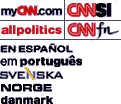
|
|
| CNN WEB SITES: |
 |
| TIME INC. SITES: | ||
| MORE SERVICES: |
| video on demand |
| video archive |
| audio on demand |
| news email services |
| free email accounts |
| desktop headlines |
| pointcast |
| pagenet
|
| DISCUSSION: |
| message boards |
| chat |
| feedback
|
| SITE GUIDES: |
| help |
| contents |
| search
|
| FASTER ACCESS: |
| europe |
| japan
|
| WEB SERVICES: |
1972: Xerox Parc and the Alto
|
||||||||||||||
|
||||||||||||||
July
8, 1999
Web
posted at: 3:47 p.m. EDT (1947 GMT)
by Leslie Goff
(IDG) -- Bob Taylor recalls taking the wind out of the sails of a secretary who had just gotten a brand new, top-of-the-line IBM typewriter. It was 1972, and Taylor was heading up a lab at a then two-year-old research facility that was working on a small interactive computer. "She was showing the typewriter off to a group of six or seven people, and I walked over and hit a couple of keys and said, 'You know, we're going to make this thing obsolete,' " Taylor says. "And everyone just looked at me like I was crazy."
Taylor was associate manager of the Computer Science Lab at Xerox Corp.'s Palo Alto Research Center (Parc) in Palo Alto, Calif. He headed up the group of brilliant, iconoclastic computer scientists who were developing the Alto, generally credited as the first PC. Taylor says he thought computers should be devices for communicating with others, not engines for making calculations; that everyone should have one; and that all computers should be networked to one another. But it took a while before he got his team interested in his vision of individual, interactive computing.
Initially, they were building a time-sharing system, a clone of Digital Equipment Corp.'s PDP-10 with a microcoded operating system. That system, dubbed the Maxc (Multiple Access Xerox Computer), was a continuation of work started by Berkeley Computer Corp. Berkeley had run out of capital, and its founders, including Peter Deutsch, had all agreed to join Parc to finish their project.
By the time the Maxc was finished, Taylor says, the team decided to take up his cause, to develop a display-based, interactive PC. They toiled to build a system that integrated the ideas of Douglas Engelbart for a graphical user interface, a mouse, a local disk drive (a 2.5M-byte removable cartridge drive) and a keyboard.
The ideas behind the Alto weren't new; rather, their time had come. Technology had advanced to the point where they were viable. And by the late 1960s, Taylor notes, it had been possible to project the falling prices of semiconductor memory. The team capitalized on that, putting 128K bytes of memory in the Alto, at a cost of about $4,000, says Ed McCreight, another Parc employee who worked on the project. He's now the principal computer scientist for advanced technology at Adobe Systems Inc.
"We threw memory at any problem we could find; that was really the cleverness of [the Alto]," McCreight adds. "Everyone said [it] was a waste. . . . But we said, 'We know memory is going to get cheaper and we want to see what we can do with it when it does.' " Now retired, Taylor says there isn't anything on today's PC that isn't a legacy of the Alto project, from the display to the software to the GUI.
In fact, over the next decade the Alto project would spawn Ethernet; Smalltalk and object-oriented programming; the first page description language and WYSIWYG graphics; and other technologies. The technologies, and the people who created them, would beget numerous Silicon Valley start-ups -- from Apple Computer Inc. to 3Com Corp. and more. But, largely a result of Xerox management, the Alto itself never became a successful commercial product.
Although founded in 1970 as a research arm for Xerox, Xerox Parc ended up functioning more like an academic research center or a national computer lab whose innovations became part of the public domain than like the research-and-development arm of a corporation. Xerox management failed to see the opportunities afforded by many of the innovations at Parc, and many key innovators ended up defecting to start their own companies.
One such missed opportunity took place when Xerox management ordered resistant Parc employees to demonstrate the Alto's GUI to an aspiring computer jockey named Steve Jobs. Apple Computer's history tells the rest of that story.
"Parc was one of the first industrial labs that was serious about keeping its research proprietary. And it is to the great benefit of the industry that they didn't succeed very well," says Deutsch, a key contributor to the development of Smalltalk. He now owns the consulting firm Aladdin Enterprises in Menlo Park, Calif.
"I was driving up [Highway] 101 the other day, and I saw six consecutive billboards for software companies," Deutsch says. "I think that at least the Parc legend, and to some extent what Parc did, contributed to making Silicon Valley the epicenter of the world computer culture."
Goff is a frequent contributor to Computerworld. Contact her at lgoff@ix.netcom.com.
RELATED STORIES:
Robots will manage your network
January 29, 1999
Book review: Starry-eyed visions of the techno-future
November 9, 1998
Don't Go Back to MUDville
January 22, 1998
RELATED IDG.net STORIES:
100 years of technology innovation
(Computerworld)
First 50 years of computing complete timeline
(Computerworld)
Flashback: Women in computing
(Computerworld)
Forecast: The next 10 years
(Computerworld)Note: Pages will open in a new browser window
External sites are not endorsed by CNN Interactive.
RELATED SITES:
Xerox PARC
Computer Museum of America
Perspectives of the Smithsonian: Smithsonian Computer History
American Computer Museum
The Computer MuseumNote: Pages will open in a new browser window
External sites are not endorsed by CNN Interactive.

